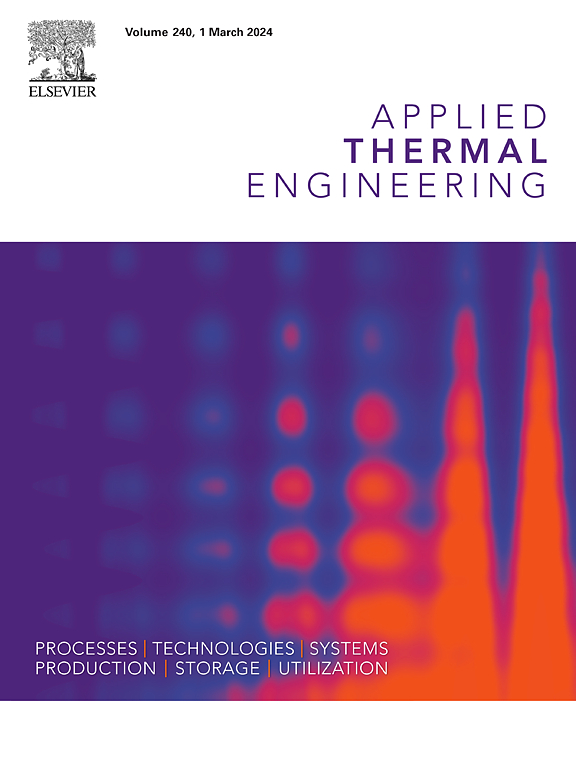高温红外探测器用微型斯特林制冷机的参数化研究及SWaP结构的优化设计
IF 6.1
2区 工程技术
Q2 ENERGY & FUELS
引用次数: 0
摘要
精确控制冷却温度的能力,同时满足严格的SWaP(尺寸,重量和功率)要求,使得微型斯特林制冷机对于当代高温红外探测器系统至关重要。本文采用半绝热热力学模型,基于单因素法对微型旋转斯特林制冷机进行了全面的参数分析。结果表明,流体流动压力损失占最大的功率损失,而蓄热器传导损失占最大的热损失。此外,活塞行程和蓄热器长度的每一微米对制冷机的整体性能和紧凑性都有影响。因此,确定了制冷机设计的可行行程为1.8 mm,蓄热器长度为24.5 mm。随着运行速度的增加,制冷机的净制冷量线性上升,可能允许更小的部件用于SWaP制冷机设计。然而,流体流动压力和机械摩擦损失急剧上升。在理想分析结果的基础上,设计了一种具有增强SWaP特性的微型旋转斯特林制冷机,该制冷机在实际输入功率为4.28 W的情况下产生0.68 W的净制冷量。在冷却温度为150 K,设计重量为177 g时,制冷机的预测性能系数为15.85%。制冷机的比冷功率为6.3,质量比冷功率为0.004,效率较高,体积小,重量轻。将所设计的斯特林制冷机与文献中的其他斯特林制冷机进行了比较,结果显示出良好的一致性。本文章由计算机程序翻译,如有差异,请以英文原文为准。
Parametric study of miniature Stirling cryocooler for high temperature infrared detector with design refinement for SWaP configuration
The ability to precisely control cooling temperature while meeting strict SWaP (Size, Weight, and Power) requirements makes miniature Stirling cryocoolers essential for contemporary high-operating temperature infrared detector systems. This study conducts a thorough parametric analysis of a miniature rotary Stirling cryocooler based on a one-factor-at-a-time approach, employing a semi-adiabatic thermodynamics model. The results show that fluid flow pressure loss accounts for the biggest power loss, while the regenerator conduction loss is the largest heat loss. Additionally, each micrometer of piston stroke and regenerator length has an impact on the cryocooler’s overall performance and compactness. Therefore, a feasible stroke of 1.8 mm and a regenerator length of 24.5 mm is determined for the cryocooler design. As operating speed increases, the cryocooler’s net refrigeration capacity rises linearly, potentially allowing smaller components for SWaP cryocooler design. However, fluid flow pressure and mechanical friction losses rise sharply. Furthermore, based on the ideal analytical results, a miniature rotary Stirling cryocooler with enhanced SWaP characteristics is designed, generating 0.68 W of net refrigeration with an actual input power of 4.28 W. The predicted coefficient of performance for the cryocooler is 15.85 % at a cooling temperature of 150 K, with a designed weight of 177 g. The cryocooler’s specific power of 6.3 and mass-specific cooling power of 0.004 are achieved, respectively, indicating relatively higher efficiency, as well as compactness and lightweight. The designed cryocooler is compared with other Stirling cryocoolers from the literature and exhibits good agreement.
求助全文
通过发布文献求助,成功后即可免费获取论文全文。
去求助
来源期刊

Applied Thermal Engineering
工程技术-工程:机械
CiteScore
11.30
自引率
15.60%
发文量
1474
审稿时长
57 days
期刊介绍:
Applied Thermal Engineering disseminates novel research related to the design, development and demonstration of components, devices, equipment, technologies and systems involving thermal processes for the production, storage, utilization and conservation of energy, with a focus on engineering application.
The journal publishes high-quality and high-impact Original Research Articles, Review Articles, Short Communications and Letters to the Editor on cutting-edge innovations in research, and recent advances or issues of interest to the thermal engineering community.
 求助内容:
求助内容: 应助结果提醒方式:
应助结果提醒方式:


